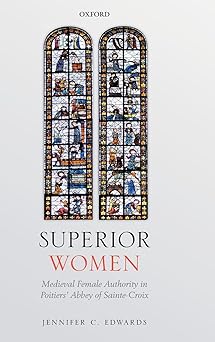
Superior Women: Medieval Female Authority in Poitiers' Abbey of Sainte-Croix
by: Jennifer C. Edwards (Author)
Publisher: Oxford University Press
Publication Date: 2019/9/12
Language: English
Print Length: 336 pages
ISBN-10: 0198837925
ISBN-13: 9780198837923
Book Description
Superior Women examines the claims of abbesses of the abbey of Sainte-Croix in medieval Poitiers to authority from the abbey's foundation to its 1520 reform. These women claimed to hold authority over their own community, over dependent chapters of male canons, and over extensive properties in Poitou; male officials such as the king of France and the pope repeatedly supported these claims. To secure this support, the abbesses relied on two strategies that the abbey's founder, the sixth-century Saint Radegund, established: they documented support from a network of allies made up of powerful secular and ecclesiastical officials, and they used artefacts left from Radegund's life to shape her cult and win new patrons and allies. Abbesses across the 900 years of this study routinely turned to these strategies successfully when faced with conflict from dependents, or more local officials such as the bishop of Poitiers. Sainte-Croix's nuns proved adept at tailoring these strategies to shifting historical contexts, turning from Frankish bishops to the kings of Frankia, then to the Pope and finally to the King of France as former allies became unavailable to them. The book demonstrates respectful cooperation between men and monastic women, and more extensive respect for female monastic authority than scholars typically recognize. Chapters focus on the cult's manuscripts, church decoration, procession, jurisdictions between cult institutions, reform, and rebellion.
About the Author
Superior Women examines the claims of abbesses of the abbey of Sainte-Croix in medieval Poitiers to authority from the abbey's foundation to its 1520 reform. These women claimed to hold authority over their own community, over dependent chapters of male canons, and over extensive properties in Poitou; male officials such as the king of France and the pope repeatedly supported these claims. To secure this support, the abbesses relied on two strategies that the abbey's founder, the sixth-century Saint Radegund, established: they documented support from a network of allies made up of powerful secular and ecclesiastical officials, and they used artefacts left from Radegund's life to shape her cult and win new patrons and allies. Abbesses across the 900 years of this study routinely turned to these strategies successfully when faced with conflict from dependents, or more local officials such as the bishop of Poitiers. Sainte-Croix's nuns proved adept at tailoring these strategies to shifting historical contexts, turning from Frankish bishops to the kings of Frankia, then to the Pope and finally to the King of France as former allies became unavailable to them. The book demonstrates respectful cooperation between men and monastic women, and more extensive respect for female monastic authority than scholars typically recognize. Chapters focus on the cult's manuscripts, church decoration, procession, jurisdictions between cult institutions, reform, and rebellion.
未经允许不得转载:电子书百科大全 » Superior Women: Medieval Female Authority in Poitiers' Abbey of Sainte-Croix


评论前必须登录!
登陆 注册